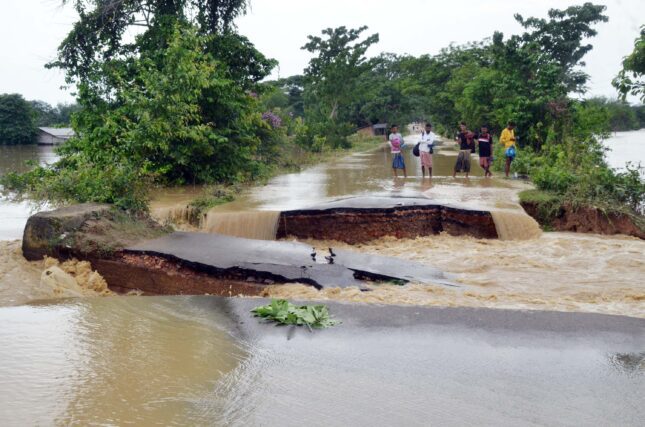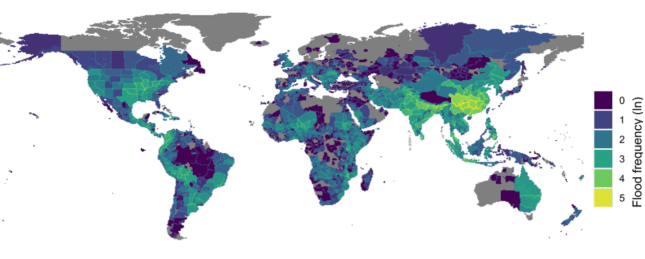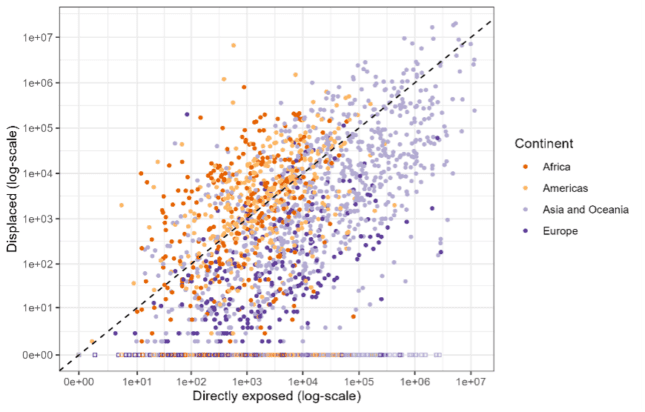-
Before the Flood: Lessons from Attempts to Predict Displacement

Severe flooding is a major cause of human displacement. According to the latest annual report by the International Displacement Monitoring Centre, around 61 million people were forced to move within their country of residence during 2022 due to conflict or disasters. More than one quarter of these—19.2 million people—were displaced by floods.
But flood displacement also varies greatly across both events and countries. What might explain this variation? Being able to predict the levels of flood displacement may help create more effective responses—especially in key areas such as lowering the risks of exposure to such events and acquiring the mobility to evade or escape them.
In a new article just published in the journal Proceedings of the National Academy of Sciences of the USA (PNAS), we sought to identify what drives variation in flood displacement. For a number of reasons, we were not able to predict the magnitude of such events with confidence. Yet, our analysis revealed a number of insights of relevance to future research as well as to policy and practice in disaster risk management.
Assessing Variation
As shown in the map below, there is large geographical variation in the frequency of flood exposure. South and Southeast Asia have the highest rates of flood disasters, whereas thinly populated areas in dry or Arctic regions are mostly devoid of flood risk.

Note: The map shows the frequency of flood disasters, 1970-2018, as recorded by EM-DAT and georeferenced by this study. Lighter colors mean more frequent flooding. Gray areas did not experience flood disaster in the period. Figure source: Vestby et al. (2023).
The global pattern in flooding also varies over time. There was a steep increase in flood disasters from 1985 until the early 2000s, after which time the trend has reversed. The volume of flood displacements also has dropped in recent decades, despite population growth and climate change contributing to rising frequency and severity of extreme weather events in many parts of the world.

Note: The graph shows the global yearly number of major flood events (blue area) and the corresponding number of flood-induced displaced persons (orange line), 1985-2020, as recorded by the Dartmouth Flood Observatory. Figure source: Vestby et al. (2023).
Declining rates of flood displacement are an indication of important progress in reducing social vulnerability to flood hazards. However, progress is not even. Flood statistics reveal large variation in displacement levels across events, even for floods that appear similar in terms of the number of persons directly exposed.
Problems in Prediction
So, what determines why some floods become major displacement events whereas in other cases exposed populations appear to cope without fleeing? Our article in PNAS was an attempt to offer a way to predict the fallout.
First, we compiled a dataset with detailed satellite-based data on the spatial extent of major flood events worldwide since year 2000, combined with high-resolution human settlement data and available statistics on the local socioeconomic, political, and security contexts for each event. A statistical analysis of ‘in-sample’ associations (i.e., where the model uses the same data for estimation and prediction) gave results mostly in line with expectation, although average effects for the predictors were weak.
We then tried to go a step further and use the results from the in-sample analysis to predict displacement levels on new data, analogous to early warning models predicting future events. Here, the contextual variables generally failed to improve the accuracy of the prediction.
How can this be? After looking more closely into the data and documentation as well as available information on selected flood events, we believe there are both conceptual and analytical reasons for our inability to predict the magnitude of new flood displacements with reasonable accuracy.
Conceptual Challenges
On the conceptual side, scientific progress is hindered by a lack of a legal and operational definition of what constitutes (flood-induced) displacement.
Internally displaced persons (IDPs) are commonly defined as “persons or groups of persons who have been forced or obliged to flee or to leave their homes or places of habitual residence, in particular as a result of or in order to avoid the effects of armed conflict, situations of generalized violence, violations of human rights or natural or human-made disasters, and who have not crossed an internationally recognized State border.”
Yet, as clear as this definition may seem, it is not plain in some essential aspects. First, it does not refer to a minimum duration of relocation. (To wit: Is one hour enough to be classified as an IDP?) It also offers no minimum threshold for distance traversed. (Is moving across the street sufficient?) At the same time, this definition is limited to movements within countries, thus excluding cross-border disaster mobility. It is also vague on whether voluntary precautionary evacuation should count as displacement.
The fact that available flood displacement data typically originate from media reports and official government statements also creates issues. These statistics are liable to subjective, inconsistent, conflicting, patchy, or even willfully misleading information on the gravity of the situation.
One recent example can be found in accounts of the devastating 2022 Pakistan floods. According to early estimates by the UNHCR on August 30, 2022, “hundreds of thousands” people had been displaced by the flooding, which had “affected” over 30 million people. This latter estimate was picked up by a September 2 news article in the journal Nature, which then claimed that the floods had caused 33 million displacements.
More recent estimates by UN OCHA, published five weeks later on October 5th, adjusted these numbers down—and quite significantly. The organization concluded that around 7.9 million persons had been displaced since June.
Analytical Challenges
Concern about the accuracy of published displacement statistics is accompanied by a number of analytical challenges to accurately predicting flood displacements.
For instance, some floods are products of tropical storms that affect much larger areas and potentially destroy densely populated settlements far beyond the inundated areas. Whether people fleeing the destructive forces of windstorms are included in the reporting on flood impacts probably varies, especially since news sources may be unable to separate between drivers of displacement.
The consequence of this muddied information flow is that the conventional measure of human flood exposure – the number of people residing on flooded land – may severely underestimate the potential total number of people who may be forced to flee when overlapping disasters strike. Unfortunately, existing flood databases do not enable separating between isolated flood events and floods that were part of compound events.
Likewise, catastrophic flooding sometimes results in cascading impacts, which again may amplify the number of people forced to flee to avoid or minimize harm. Flood-induced breakdowns of electric power supply, telecommunication, transportation infrastructure, food markets, and health services are among the many hazards faced in such circumstances.
The extent to which floods generate such secondary impacts is largely determined by the vulnerability of exposed societies. The figure below plots the ratio between direct flood exposure and reported displacements for all flood events with complete data.

Note: The figure shows flood displacement as a function of population exposure. Each dot represents a flood event, with colors indicating geographical region. Figure source: Vestby et al. (2023).
Many of the floods that caused especially high levels of displacement—in some cases exceeding the estimated number of people residing in the flooded areas—occurred in Africa. Higher prevalence of compound events and cascading impacts can explain this pattern. Yet, less precise exposure and displacement estimates are also probably at play. In contrast, European floods tend to have low displacement-to-exposure ratios, indicating lower average levels of vulnerability.
What We Learned
Not being able to predict flood displacement intensity well does not mean that we do not take away valuable insights from looking deeper into these events.
It should be noted that although disaster displacement often is framed as an adverse impact and taken as evidence of lack of adaptation, mobility also is an important coping mechanism—especially when the alternative could be severe risk of loss of life. Households with limited access to skills and resources are more likely to be involuntarily immobile during disaster. Similarly, a new study suggests that adverse effects of climate change may reduce migration rates in the Global South more generally.
We also concluded that actors working toward disaster risk reduction thus should adopt a two-pronged approach that on the one hand aims to lower hazard exposure and on the other enable greater mobility options to manage unavoidable risks. In this sense, the end goal is not necessarily to reduce overall levels of displacement in the future, but rather to build resilience and ensure that (im)mobility responses to floods will be safer and occur with greater human agency.
Read the new article here (open access): Vestby, J., Schutte, S., Tollefsen. A.F., Buhaug, H. 2023. Societal determinants of flood-induced displacement. Proceedings of the National Academy of Sciences. https://doi.org/10.1073/pnas.2206188120
Authors: Halvard Buhaug is Research Professor at Peace Research Institute Oslo (PRIO), Professor of Political Science at the Norwegian University of Science and Technology (NTNU); and Associate Editor of Journal of Peace Research. He served as chapter Lead Author in the recent IPCC Sixth Assessment Report. Jonas Vestby, is Senior Researcher at Peace Research Institute Oslo (PRIO).
Sources: Carbon Brief; Dartmouth Flood Observatory; Environment and Urbanization; Environmental Research; Global Environmental Change; Global Flood Database; Internal Displacement Monitoring Centre; IPCC; Nature; New Humanitarian; Proceedings of the National Academy of Sciences of the USA; Relief Web; Sustainability; UNHCR; United Nations Office for Disaster Risk Reduction World Meteorological Association
Photo credit: Floods washed away a huge portion of Nagaon to Kampur road at Kathiatoli Village, Assam, India, courtesy of Simanta Talukdar/Shutterstock.com
 A Publication of the Stimson Center.
A Publication of the Stimson Center.










